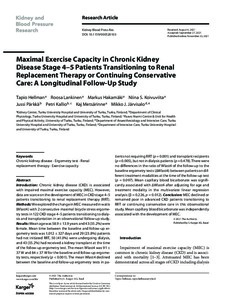Maximal Exercise Capacity in Chronic Kidney Disease Stage 4-5 Patients Transitioning to Renal Replacement Therapy or Continuing Conservative Care: A Longitudinal Follow-Up Study
Hellman Tapio; Lankinen Roosa; Hakamäki Markus; Koivuviita Niina S.; Pärkkä Jussi; Kallio Petri; Metsärinne Kaj; Järvisalo Mikko J.
https://urn.fi/URN:NBN:fi-fe2022021619372
Tiivistelmä
Introduction: Chronic kidney disease (CKD) is associated with impaired maximal exercise capacity (MEC). However, data are scarce on the development of MEC in CKD stage 4-5 patients transitioning to renal replacement therapy (RRT).
Methods: We explored the change in MEC measured in watts (Wlast4) with 2 consecutive maximal bicycle stress ergometry tests in 122 CKD stage 4-5 patients transitioning to dialysis and transplantation in an observational follow-up study.
Results: Mean age was 58.9 ± 13.9 years and 43 (35.2%) were female. Mean time between the baseline and follow-up ergometry tests was 1,012 ± 327 days and 29 (23.8%) patients had not initiated RRT, 50 (41.0%) were undergoing dialysis, and 43 (35.2%) had received a kidney transplant at the time of the follow-up ergometry test. The mean Wlast4 was 91 ± 37 W and 84 ± 37 W for the baseline and follow-up ergometry tests, respectively (p < 0.001). The mean Wlast4 declined between the baseline and follow-up ergometry tests in patients not requiring RRT (p = 0.001) and transplant recipients (p = 0.005), but not in dialysis patients (p = 0.478). There were no differences in the ratio of Wlast4 of the follow-up to the baseline ergometry tests (∆Wlast4) between patients on different treatment modalities at the time of the follow-up test (p = 0.097). Mean capillary blood bicarbonate was significantly associated with ∆Wlast4 after adjusting for age and treatment modality in the multivariate linear regression analysis (β = 0.226, p = 0.012).
Conclusion: MEC declined or remained poor in advanced CKD patients transitioning to RRT or continuing conservative care in this observational study. Mean capillary blood bicarbonate was independently associated with the development of MEC.
Kokoelmat
- Rinnakkaistallenteet [27094]
